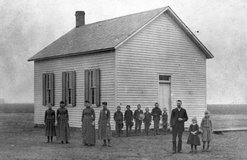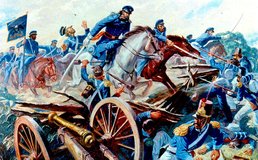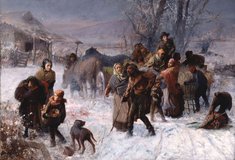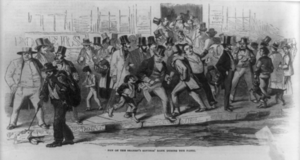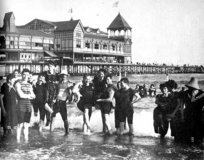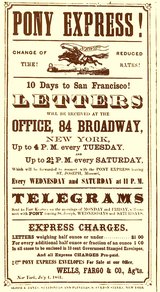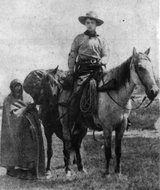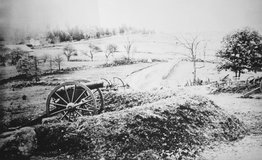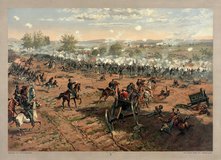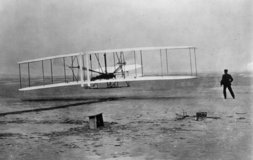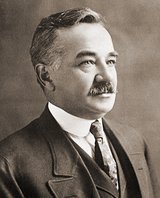Andrew Jackson born, 1832
Andrew Jackson was born on 31 October 1832, in Crawford County, Pennsylvania. His mother was Hannah Gardner and was 20 years old when Andrew Jackson was born. His father was Robert Kerr and was 27 years old at the time. Andrew Jackson was the second of 11 children. His older sibling Esther Jane was 2 years old when he was born.
Pennsylvania, 1832
During the 1800s, numerous European immigrants relocated to Pennsylvania in search of religious freedom and new economic opportunities. The state's rolling hills, plateaus, rivers, woodlands, and vast farmlands made it a strong agricultural and fur trapping region. Cities like Philadelphia and Pittsburgh also became major industrial centers, attracting thousands of factory workers. Around 2.5 million people lived in Pennsylvania during Andrew Jackson's time—with a mix of farmers, merchants, woodsmen, and factory workers making up much of the population.
Childbirth
Though medical technology had advanced quite a ways in the 19th century, Andrew Jackson's mother still assumed significant risks when she gave birth to him. At this time, the average American mother gave birth to six children over her life, and while doctors were more available to help in these pregnancies than in generations past, a majority of births occurred in the home—making hygiene and sanitation extremely important. The invention of forceps, the use of chloroform as anesthesia, and advances in laceration repair helped reduce the pain and risks. Nonetheless, a significant number of infants still died from preventable sicknesses.
Brother David G. Kerr born, 1834
Andrew Jackson's brother, David G., was born when Andrew Jackson was 1 year old.
Esther Alice Carroll born, 1836
Andrew Jackson's future wife, Esther Alice Carroll, was born 4 years after Andrew Jackson. Esther was born in Mercer, Pennsylvania, United States.
Cheyney University, 1837

One of the buildings on the Cheyney campus
In the wake of severe race riots in Pennsylvania in the late 1820s, local Quaker philanthropist Richard Humphreys set aside $10,000—a considerable sum at the time—to establish the first school of higher education exclusively for African-Americans. Opened in 1837 in Philadelphia, the school was initially known as the Institute for Colored Youth, and focused on trade skills and agriculture to help African-Americans compete for equal employment. Over time, the school became a beacon for thousands of young students in Andrew Jackson's state, and—more than a century later—would evolve into Cheyney University of Pennsylvania.
Childhood
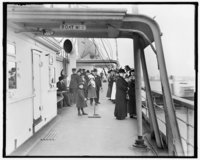
Children playing quoits
Work and education shaped Andrew Jackson's childhood. Society expected children between four and eight years old to help with basic cooking, cleaning, farming, or any other task that needed doing. Even though families started having fewer children, many still forsook education in order to contribute more to the family farm or business. With many fathers lost to war and mothers lost to illness or in childbirth, eldest children often had great responsibilities cast upon them at a young age.
Trail of Tears, 1838
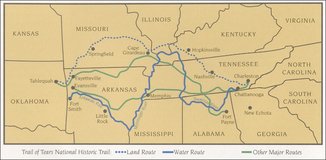
A Map of the Trail of Tears
5 year-old Andrew Jackson lived through one of the most tragic events in United States history: the Trail of Tears. After years of tense coexistence with Native Americans, then-president Andrew Jackson passed the Indian Removal Act, forcefully evicting all tribes east of the Mississippi River. Around 1/3 of the Cherokees, Muscogees, Choctaws, Chickasaws, and Seminoles that were forced to move died on the 1,200 mile-long winter trail. Those that survived were forced to live in hostile reservations around modern-day Oklahoma and Arkansas, far from the lands that had been their home for hundreds of years.
Sister Mary Ann born, 1839
Andrew Jackson's sister, Mary Ann, was born when Andrew Jackson was 6 years old.
Education
During the 1800s, formal education opportunities for Andrew Jackson and other children expanded greatly throughout the United States. One-room schoolhouses (with one teacher for all grades) were still common in small towns, with roughly 200,000 in use during Andrew Jackson's life. But with many states beginning to offer free public education, children in more densely populated regions were attending new, large-scale school buildings, as well. For all the improvements, however, boys were still encouraged to attend school more than girls, and African-Americans and other minority groups were still segregated and unable to gain the same advantages.
Whig Convention, 1839
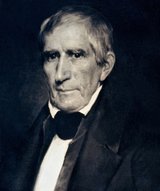
William Henry Harrison
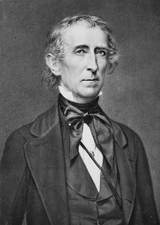
John Tyler
When Andrew Jackson was 7, the Whig Party convened in Harrisburg, Pennsylvania, seeking to unite the party behind a single candidate for the U.S. presidency. Divisions within the party had weakened its power in recent years, so many of the Whigs in Andrew Jackson's region of Pennsylvania traveled to the convention in December of 1839 to find common ground. War hero William Henry Harrison was eventually chosen as the Whig candidate for the 1840 election, with John Tyler as his running mate. With the country in the midst of a depression, incumbent Martin Van Buren was easily defeated a year later by Harrison, inspiring new hope among many people both in and out of the Whig Party.
Improved Transatlantic Mail, 1840
On July 17, 1840, when Andrew Jackson was 7, a 63 meter-long wooden steamship arrived in Halifax, Canada just 12 short days after leaving Liverpool, England. Its arrival in Boston only a few days later proved that steamships could make the Liverpool-Halifax-Boston mail route in only 14 days and 8 hours, much faster than a sailing ship. The use of steamships along the route allowed correspondence from people in Andrew Jackson's community to be delivered faster than ever before.
Mother dies, 1842
Andrew Jackson's mother Hannah Gardner passed away in Oil Creek Township, Crawford, Pennsylvania, United States at the age of 29. Andrew Jackson was 9.
Brother James Rulin born, 1843
Andrew Jackson's brother, James Rulin, was born when Andrew Jackson was 10 years old.
Telegraph, 1844
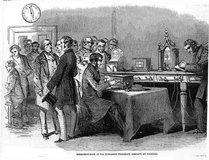
A telegraph message being received
"What hath God wrought!" With these words, sent over the newly constructed telegraph line that linked Washington DC to Baltimore, Samuel Morse instigated a revolution in communication in the United States. The fateful message was sent on the 24th of May, 1844, when Andrew Jackson was 11.
The Washington-Baltimore line was the first long distance telegraph line in the United States. Morse was one of several men who had recently invented telegraph machines, which sent short static bursts over electrical lines to be received on the other end of the wire as clicking sounds. He also helped invent a code where each letter in the alphabet was represented by short or long electrical clicks, allowing words to be transmitted quickly.
With the success of the Baltimore-Washington line, soon telegraph lines were connecting cities and communities across the country. St. Louis was connected to the East Coast in 1847, and the West Coast received its first connection to the East Coast in 1861. These developments allowed for messages to be sent across the nation, helping Andrew Jackson's community stay in contact with friends and family members, as well as aiding businesses and government enterprises. No such immediate forms of long-distance communication had ever been achieved before, and many people in Andrew Jackson's time were in awe of the technology.
Hygiene
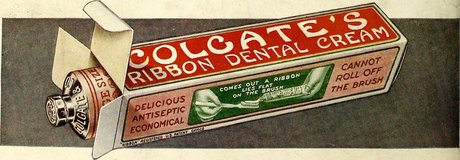
Colgate toothpaste, sold since 1873
During the 1800s, bathing started to become more commonplace for those around Andrew Jackson. The arrival of how water heaters later in the century certainly made the prospect even more appealing. Andrew Jackson's friends and neighbors used soap made from animal fat and wood ashes to bathe, as well as to wash clothes and clean the house. A greater appreciation for personal cleanliness, coupled with a wider array of perfumes and odor maskers, drastically reduced the stench of heavily trafficked streets.
In terms of oral hygiene, the average American was still unlikely to brush his or her teeth on a regular basis, let alone floss. Toothbrushes and toothpaste existed, but weren't being mass produced in the U.S. until the 1880s. Brush bristles of the time were often made from rather coarse boar's hair—not always the most gentle feeling on the gums. For feminine hygiene, women continued using cotton cloths until manufactured cloth pads became available in the mid-1800s.
In the 19th century, doctors started recommending that mothers change infant's diapers more frequently. Diapers were made from cloth and were sometimes cleaned simply by drying them by a fire. Over time, greater effort was made to properly clean and replace these babies' clothes and diapers, helping to limit infections and diaper rash.
Mexican-American War, 1846 - 1848
When Andrew Jackson was 13 years old, relations between Mexico and the United States were extremely volatile, especially following the annexation of Texas and disputes over the Texas/Mexico border. United States General Zachary Taylor pushed troops to the Rio Grande under the assumption that it was the Texas border, but Mexico did not agree. The Mexican government viewed the American troops as an invading force and sent their own army to push them out. The forces collided in the Battle of Palo Alto, the first battle of the Mexican-American War. Congress officially declared war on Mexico following the battle, but the move was not universally supported. Some Americans, including future president Abraham Lincoln and many other Northerners, believed that President James K. Polk had provoked the fighting with his rogue stance on the border. Abolitionists also felt that the war was an attempt to continue the expansion of slavery by providing more territory and power for slave owners. Many people who opposed the war tried to resist paying additional taxes to fund the military.
Regardless of the general disapproval, the war raged on. Using the same superior weaponry and tactics that had won the conflict at Palo Alto, American troops were able to defeat Mexican soldiers again at the Battle of Resaca de la Palma. The Mexican army, led by General Antonio López de Santa Anna, continued to lose battles and men, as the United States pushed further into Mexico. General Winfield Scott led the United States army into Mexico City and attacked Chapultepec Castle. The intense military pressure forced Santa Anna to relinquish his post, and the fall of the Mexican capital on September 17th, 1847, marked the end of the fighting. The Treaty of Guadalupe Hidalgo was signed on February 2nd, 1848, officially ending the war. The treaty awarded the United States an additional 525,000 square miles, over half of Mexico's land, including either all or parts of present-day Arizona, California, Colorado, New Mexico, Nevada, Wyoming, and Utah. In addition, Mexico was forced to recognize that Texas was a part of the United States (although this had technically been official for three years) and the border of Texas was set as the Rio Grande. In return, Mexico received a payment of $15 million for the land handed over to the United States (also known as the Mexican Cession). The land gained allowed American settlers to push further across the continent, and helped further the ideals of Manifest Destiny.
Clothing
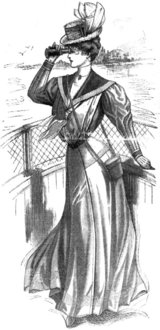
An example of Victorian fashion for women
Fashion trends in the United States went through many variations during Andrew Jackson's life, but there were some consistencies that spanned economic classes, with both frontier men and wealthy urban businessmen often favoring a formal look, with long wool frock coats and trousers, vests, large bow ties, and sturdy leather boots. Women on a wagon train might wear a long, one-piece cotton or wool dress in a flower print or plaid pattern, with a bonnet, an apron, and/or a shawl as accessories. Victorian styles influenced American women, too, with many sporting elaborate, frilled ankle-length skirts, camisoles, petticoats, form fitting jackets, and highly restrictive corsets. Hats were worn by most of the men Andrew Jackson knew, be it a Lincoln style silk top hat, a simple straw cap, or a western cowboy hat. Long beards and mustaches, well coiffed, were also common.
Religion
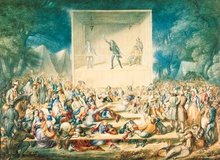
Methodist camp meeting, 1839
Religion played a large role in local and national governments throughout Andrew Jackson's lifetime. Almost 70% of religious Americans in the 19th century identified with some Christian denomination, including Catholicism, Methodism, Lutheranism, and the Baptist Church. Increased immigration brought other religions such as Judaism, Islam, and Buddhism, promoting greater religious diversity—although the relationships between these groups were not always cordial. In the 1840s, Irish and German Catholic immigrants met with some persecution from other Americans, who feared that Catholicism would erode Protestant American values. Some Protestant denominations themselves began to split into northern and southern factions as the struggle between the North and South grew more bitter over the issue of slavery. Northern abolitionists in particular used Protestant Christian imagery and language to help sway others to their cause.
Many of Andrew Jackson's Christian neighbors attended religious services regularly and grew close to their church community. Although the United States Constitution forbid the national government from establishing a national church, states were not faced with the same restriction. Many New England states maintained a special relationship with the Congregationalist Church during this era. However, pressure from other faiths caused many of these state governments to gradually stop favoring a particular church.
Andrew Jackson's community also heard news of Baptist and Methodist preachers making their way across America and converting followers. These preachers of the Second Great Awakening railed against the sinfulness of humanity, beseeching their audiences to give up their wicked ways and convert. As a result, both the Methodist and Baptist Churches gained a large number of converts, becoming two of the largest Protestant groups in the nation. By the 1830s, the Mormon Church was drawing converts, as well, but began to suffer persecution from their neighbors. Meanwhile, in New England, intellectual circles began to adopt Unitarian ideas. This new movement, although smaller than the others sweeping through Andrew Jackson's community, was influential at the national level.
Brother John C. born, 1848
Andrew Jackson's brother, John C., was born when Andrew Jackson was 15 years old.
Brother Warren born, 1849
Andrew Jackson's brother, Warren, was born when Andrew Jackson was 16 years old.
Fugitive Slave Act, 1850
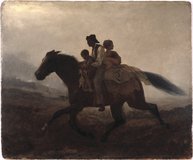
Fugitive slaves
By 1850, when Andrew Jackson was 17, the rise of the Northern abolitionist cause in American politics had some leaders in the South calling for secession from the Union. In an attempt to ease these tensions and maintain Southern loyalty, Congress passed the Compromise of 1850, which included an update to the country's existing "Fugitive Slave Act." The new laws reduced the rights of runaway slaves, offering rewards for their return and requiring citizens to assist in their capture. While some slave owners were pleased with the compromise, abolitionists and many politicians in the North were outraged. Rather than easing North/South tensions, the risk of a division in the Union looked more and more like an inevitability.
Underground Railroad, 1850
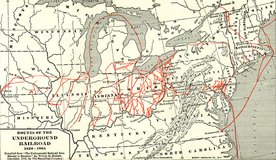
Some Underground Railroad routes

Harriet Tubman, an Underground Railroad leader
When Andrew Jackson was a teenager, the Underground Railroad was working at full force to secretly transport escaped Southern slaves into free Northern states. Vigilance committees in larger cities like New York, Philadelphia, and Boston were also forming to help provide food and supplies to these newly free men and women. By 1850, it is estimated that around 100,000 slaves had escaped using the Underground Railroad's network of travel routes and shelters. Supporters of the railroad saw it as a great cause for justice and morality, but many plantation owners—viewing slaves as property—considered the network a form of organized thievery.
Marriage
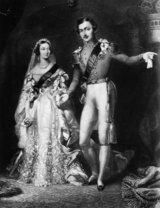
Queen Victoria’s white wedding gown set the tradition that continues to today
As America expanded further west and became more of a melting pot back east, views about marriage slowly shifted. Rather than having marriages arranged or negotiated by outside parties, most relationships in Andrew Jackson's community had to be agreed upon by both spouses. As people brought their different faiths to the United States throughout the 19th century, the types of religious wedding ceremonies practiced in the country became more and more varied. Women were also having greater say in marriages, thanks in part to the added responsibility cast upon them during several wars. In cases of divorce, a woman could now claim custody of her children.
With more people settling in smaller homes in cities, couples had fewer children on average. Society still viewed proper family roles as a mother raising the children and keeping a good home, while the father worked and provided resources. However, women's rights advocates were beginning to fight against this simplified view.
Marriage customs were unique for Mormons around Andrew Jackson, as some practiced polygamy. The goal of many Mormons was to be married in the temple, which couples believed would allow them to be together for eternity, rather than just until death. This was difficult to manage during Andrew Jackson's life since there were only a few temples constructed in the United States.
Diet

Cornbread
It's no coincidence that Americans started eating better and expanding their palates at the same time that technology was improving transportation and hygiene. While Andrew Jackson knew many people who still relied on subsistence farming, those same farmers could also now sell and ship their food to cities far and wide. Some popular new foods, like Rocky Mountain oysters, stayed regional. Others, like peanut butter, corn bread, fried chicken, and flavored soda water, slowly spread across the country, sold at local groceries and restaurants. Food purchased at a store could then be taken home and prepared safely using an open hearth or cast-iron gas stove.
Uncle Tom's Cabin, 1852
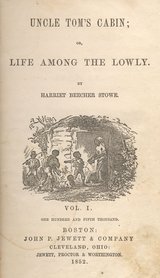
The cover of an early pressing of Uncle Tom's Cabin
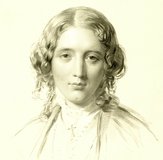
Portrait of Harriet Beecher Stowe by Franic Holl
On the 20th of March, 1852, the novel Uncle Tom's Cabin was released to the world, and quickly caused a firestorm of of controversy. The book was written by Harriet Beecher Stowe, who came from an established New England family, and was inspired by her meeting with an escaped slave while living in Cincinnati, as well as her own disgust at the strengthening of America's fugitive slave laws. The book became immensely popular in the northern states, where it was credited with changing the popular conception of slavery and greatly swelling the ranks of the abolitionist movement. Meanwhile, in the South, the book was met with loathing and denounced as an irresponsible exaggeration. The work catapulted Stowe into the ranks of the highest literary figures of the English-speaking world and would have caused a great deal of controversy and discussion in Andrew Jackson's community.
Military

A common musket during the Civil War
During the 1800s the US was involved in several military conflicts, including the War of 1812 and the Civil War. The Civil War was the first time that the United States used a draft to obtain soldiers. Of the 2,100,000 Union soldiers, 2% were draftees, 6% were substitutes paid by draftees, and the rest were volunteers. Union privates were paid 13 dollars per month, while officers were paid anywhere from 50 to 700 dollars per month, which varied depending on the officer's rank. Members of the Southern military were paid similar to Union soldiers.
When men weren't at war, the women around Andrew Jackson were expected to devote their lives to cleaning up after and nurturing their husband and children. During the Civil War, however, their role changed. Women signed up to work as nurses and joined volunteer brigades. Women also served on the front lines by cooking and cleaning up for the soldiers, and their efforts helped to make conditions on the front lines more sanitary. Women in Andrew Jackson's community acted as everything from nurses to spies, and maintained the home front in the absence of the men. While women were not allowed to enlist, some disguised themselves as men and fought and died in the Civil War.
Medicine
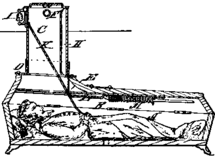
A coffin bell, used to notify the living if a corpse regained consciousness
Andrew Jackson lived during a time of great medical progress, as increased understanding of human anatomy was helping doctors and scientists come up with better solutions for many of the diseases, infections, and unsanitary conditions plaguing American life. The stethoscope was invented around this time, along with blood transfusions, cholera vaccines, laughing gas, and a number of new anesthetics. Those of Andrew Jackson's friends that lived in or near large towns or cities benefited much sooner from these advances than those that lived in more rural areas.
As a further issue, only a handful of medical colleges and hospitals existed in the United States during Andrew Jackson's life, and high infant mortality rates— along with often devastating outbreaks of chicken pox, measles, mumps, and whooping cough— kept the average lifespan barely above 40. Death, to put it bluntly, was a very common part of life.
In another morbid part of 19th century life, some of Andrew Jackson's deceased friends or family may have actually been buried with a shovel or pickaxe in their coffin. Why? Because with many doctors still not able to diagnose whether a patient was in a coma, relatives wanted to be sure the dearly departed had a fighting chance just in case he woke up after his funeral!
Panic of 1857, 1857
When Andrew Jackson was 24, the entire U.S. and much of the world was rocked by the Panic of 1857—a devastating economic recession that put thousands out of work. The great boom of the railroad industry and gold rush in the 1800s led to this inevitable bust, as mines dried up and overstretched railroad companies collapsed—costing investors millions and preventing farmers from shipping their goods back east. Within one year alone, more than 5,000 American businesses folded, as rising unemployment took its toll on many of Andrew Jackson's friends and family.
Entertainment
In the 1800s, new technologies provided Andrew Jackson with more leisure time to relax and enjoy entertainment rather than work on the farm or conduct business. Minstrel shows, circuses, and museums popped up all across America. In cities, people attended shows that featured a multitude of acts, which eliminated social boundaries by allowing people of every economic class to attend. New methods of transportation allowed people who could afford it to travel to beaches and countrysides for idyllic family vacations. At the tail end of the 1800s, people flocked to amusement parks like Coney Island in New York seeking cheap adventures, an activity that once again crossed social and economic divides.
Oil Rush, 1859
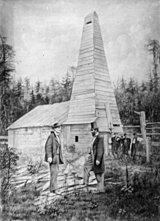
An early oil well in Pennsylvania
When Andrew Jackson was in his 20s, Western Pennsylvania, specifically Titusville and the surrounding towns, experienced the first oil boom in the United States. Oil wells and refineries shot up across the region and many around Andrew Jackson went to work in one of these towns to make a living off of the most valuable commodity in the United States. Titusville grew from around 250 residents to over 10,000 almost overnight.
Pony Express, 1860
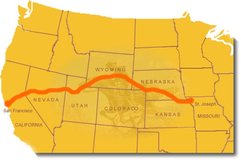
Pony Express route
When Andrew Jackson was 27, people across the country were abuzz about the implementation of the Pony Express, which revolutionized the exchange of information throughout the western United States. Instead of a haphazard system using unrecorded horses, the Postal Service established relay stations throughout the West that provided a place for riders to sleep and switch to fresh horses. Though this system drastically improved the speed at which Andrew Jackson and his friends received mail and information, it was proved obsolete in 1864 when the transcontinental telegraph allowed for instant transfer of information.
Household

19th century house

Kitchen
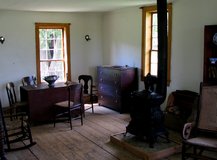
Parlor

19th century house
Throughout Andrew Jackson's life, housing was changing and evolving as Americans were pushing toward a distinct identity. Since settlers came from Germany, France, Spain, and England, housing was dictated by wealth and varied architecturally—but framed timber or rock was generally used. For Andrew Jackson's friends and family, beds were made individually with no standard size and held mattresses stuffed with either straw or feathers. To heat the house, a chimney was placed in the middle of the home, doubling as a stove.
Typical houses had two rooms, but some families could afford two-story homes (with separate bedrooms for parents and children) or even stately manors on par with some of the nicer homes in Europe. Families generally had tables where they would sit to eat their meals. Most furniture was custom-made, but later in the 1800s, it became easier to purchase affordable, mass-produced goods with which to furnish a home.
Civil War, 1861 - 1865

Battle of Antietam

Battle of Gettysburg
When Andrew Jackson was 28 years old, the Civil War—the bloodiest conflict in American history— began. Living in the Northern state of Pennsylvania, Andrew Jackson found himself mostly among Union sympathizers, who were seeking to defeat the Southern Confederate uprising, eliminate slavery, and preserve the Union. About 22 million people lived in the North, while the South's much smaller population of 9 million included 3.5 million slaves. From Pennsylvania alone, over 400,000 soldiers joined the Union forces.
The Civil War would carry on for more than four years, with battles like Antietam, Bull Run, and the Pennsylvania-based Battle of Gettysburg pitting "brother against brother" in the most gruesome of conditions. With hundreds of men from Andrew Jackson's region sent to fight, and trade from Southern states cut off entirely, there was great suffering on the homefront, as well. Food was skyrocketing in price, and women were increasingly forced to take over much of their departed husband's labor to make ends meet. By the war's end, the Union had prevailed, but an estimated 700,000 American soldiers in total had died—more than the American Revolution, both World Wars, and Vietnam combined.
Homestead Act, 1862
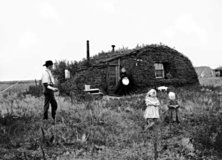
A homestead on the American frontier
When Andrew Jackson was 29 years old, many Americans were excited to learn about the Homestead Act. This act allowed citizens to claim up to 160 acres of free land in the West, inspiring many people to pack their belongings and head for the frontier with the hopes of establishing a successful farm and a new life. In order to keep the land they wanted, homesteaders had to "prove their claim," which meant they needed to make improvements, build a house, and farm the land for five years. Not everyone was able to take advantage of this opportunity, however, as many people did not have the financial means to travel west, run a farm, or build a house. Additionally, the land that homesteaders were given often came from Native Americans, who were forced to give up their land and move to reservations across the West.
Morrill Anti-Bigamy Act, 1862
Ever since its introduction, the practice of polygamy by Mormons had caused significant controversy both in and out of the Church. In 1862, the federal government took action to curtail the practice by passing the Morrill Anti-Bigamy act. This act—which specifically targeted the Mormons—was the first of several anti-polygamy laws passed in the 19th century. It officially made it illegal to practice polygamy in the United States and also reduced the amount of land the Church could own. Many of the Mormons around Andrew Jackson were concerned at the potential consequences of this legislature, and worried the day might come where they would be forced to choose between their country and their religion.
Marries Esther Alice Carroll, 1862
On 11 September 1862, Andrew Jackson was 29 when he married Esther Alice Carroll who was 25 at the time.
Gettysburg, 1863
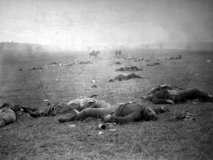
Bodies on the battlefield at Gettysburg

Lincoln's handwritten copy of the Gettysburg Address
On July 1st, 1863, the Battle of Gettysburg began. Fought in the small town southwest of Harrisburg, it became a key turning point in the Civil War—with an impact felt not only by Pennsylvanians like Andrew Jackson, but by millions of people in both the North and South. Although the battle lasted only three days, the casualty numbers approached a combined 50,000, making it one of the largest and bloodiest battles in American history. Despite the heavy losses on the field, the battle was also a major victory for the North, and helped swing momentum in favor of the Union, preventing the northward movement of the Confederate army and ultimately helping to win the war. From Pittsburgh to Philadelphia, Pennsylvanians followed the events—reacting in horror to the death toll, and hoping that the Union's success would prevent the war from advancing further into the state.
A few months after the battle, on November 19th, President Lincoln traveled to Gettysburg to speak at the dedication of a cemetery for those lost in the fighting. He spoke for only two minutes, but the Gettysburg Address would be remembered for centuries to come: "We here highly resolve these dead shall not have died in vain; that the nation shall have a new birth of freedom, and that government of the people, by the people, for the people, shall not perish from the earth."
Emancipation Proclamation, 1863
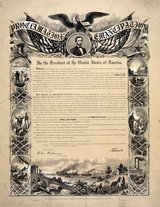
The 1863 Emancipation Proclamation
For years, newspapers in Andrew Jackson's community had been consumed with the national debate over the issue of slavery. The South fought tooth and nail against the North's attempts to curtail their rights to own and profit from slaves. For every free state that entered the United States, the South wanted another pro-slavery state added.
At first, President Lincoln tried to balance these competing interests. But as the Civil War erupted, his Republican party quickly realized that the only way to win a war with the slave-holding South was to make it a war on slavery. In 1863, when Andrew Jackson was 30, Lincoln's Emancipation Proclamation legally ended slavery in slave-holding states. African-Americans rejoiced, and some simply left their plantations to join the Union Army. Others stayed in their towns and plantations, hoping to receive wages for their labor. Still others headed north with their belongings loaded on carts, singing hymns on their way to a new life.
While Northerners in general did not view African Americans as equals, Lincoln's proclamation found support in most Northern communities. Despite its outrage, the South was largely powerless to stop the exodus of former slaves, as the able-bodied white men were off fighting with the Confederate Army.
Son Milton E. born, 1863
On 15 July 1863, Andrew Jackson's son, Milton E., was born when Andrew Jackson was 30 years old. The family was living in Oil City, Venango, Pennsylvania, United States at the time.
Transportation

Steamboat
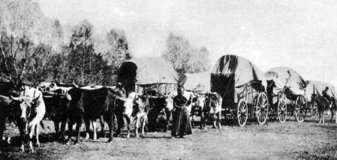
Wagon train
As more of Andrew Jackson's friends and family traveled west during American expansion, technology made some significant leaps to help them get there. What started with river boats and wagon trains quickly evolved into canals and railroads, as both people and goods were transported with a speed and efficiency never before possible. A century that started with Lewis and Clark's slow journey into the unknown eventually led to the first coast-to-coast railroad by the late 1860s. For day to day life, though, most people around Andrew Jackson still relied on traveling by foot—with only the occasional horse, buggy, or wagon for longer trips.
Lincoln Assassination, 1865

The train from Lincoln's funeral procession

Ford's Theater, where President Lincoln was assassinated
On April 15, 1865, when Andrew Jackson was 32, President Abraham Lincoln was assassinated by John Wilkes Booth while attending a play at Ford's Theatre. The Civil War had officially ended just five days earlier, and a furious and vengeful Booth supported the defeated Confederacy. Americans like Andrew Jackson learned about the President's death quickly as flags were at half-staff and businesses were closed by the next day. Millions of Andrew Jackson's fellow countrymen attended open-casket viewings as a train carried Lincoln's body on a winding journey from Washington DC to Illinois, passing through Pennsylvania, New York, Ohio, and several other states. The end of the bloody and destructive war, which had been a time of rejoicing for many Americans, had now become a time to mourn.
Son Ralph C. born, 1865
On 21 February 1865, Andrew Jackson's son, Ralph C., was born when Andrew Jackson was 32 years old. The family was living in Mercer, Mercer, Pennsylvania, United States at the time.
13th Amendment, 1865

Celebration erupts after the amendment is passed
After the Civil War ended in 1865, when Andrew Jackson was 33, the 13th Amendment was passed, freeing all slaves within the United States. Black citizens and some white Americans celebrated across the United States, but they also knew and felt racist sentiments that had grown through decades of slavery and oppression. Shortly after their readmission to the Union, many Southern states began to pass "Black Codes" to restrict the freedoms of former slaves. Many new laws included provisions stating that black men must have written documentation of employment, while others sought to restrict African Americans from holding any profession except farm laborer. As a result, many former slaves worked as sharecroppers on land owned by wealthy farmers and paid part of their crop as rent. Unfortunately, the poverty and poor living conditions most sharecroppers endured were not much different from what they had experienced as slaves.
First Transatlantic Cable, 1866
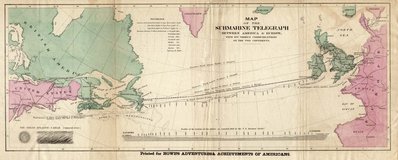
Map of the transatlantic cable
In 1866, when Andrew Jackson was 33, a permanent telegraph line was laid across the Atlantic Ocean by the British ship, Great Eastern. This was eight years after the creation and eventual failure of the first attempt at a transatlantic cable. This new line was able to re-establish communication between England and North America and sustain it—enabling messages to be delivered long distance in a matter of minutes rather than days by steamship.
Typewriter, 1867
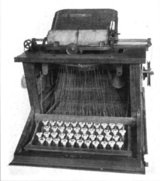
An early Sholes's typewriter
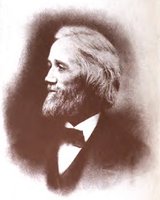
Christipher Latham Sholes
Andrew Jackson was 34 when Christopher Latham Sholes introduced his prototype for the modern typewriter. Sholes's invention improved on prototypes that had already been introduced. He helped solve the jamming problem of previous models and introduced the "QWERTY keyboard." However, the improved invention was not immediately successful. Sholes sold the rights to E. Remington & Sons, and the money from the sale would be the only profits he would ever see. But as time went on, more and more journalists, clerks, and company officials found typing faster than writing by hand—and the device eliminated misunderstandings caused by bad penmanship.
These early typewriters were very close to the standard design that would emerge in later years, but with a few noticeable differences. The early models were based on the 'up strike' method: the paper would be affixed to a cylindrical roller, and the letters would strike upward against the paper. However, with these designs, typists were unable to see the words being printed as they typed them. Early typewriters also only printed in uppercase letters—the 'shift' key would not be introduced until 1878. Despite these issues, Sholes's typewriter was beginning to revolutionize business and communication in Andrew Jackson's community. By the early 20th century, his invention could be found in most businesses and many homes.
Communication

A telegraph machine
Many public libraries began to pop up across the United States during Andrew Jackson's lifetime, giving the general public unprecedented access to books once only available to the wealthy. Newspapers gained in popularity, but in much of the country, word of mouth was still the trusted way of spreading vital information. Eventually, the development of the telegraph, railroads, and steam-powered ships helped information spread faster than ever. With these technologies, Andrew Jackson and his friends were able to stay better connected to local, national, and world news, alike.
As for communicating with friends and loved ones, the United States Postal Service was expanded and refined during these years, giving Andrew Jackson a simple, reliable way to stay in touch with people anywhere in the country.
Avondale Mine Disaster, 1869
In 1869, the Avondale Mine just outside of Plymouth, Pennsylvania suffered the worst mining disaster in American history up to that point. On September 6, when Andrew Jackson was 36, the wooden lining of the only entrance and exit of the mine caught fire. Because of the location of the fire, 108 miners were trapped inside and eventually suffocated. After the world heard about the disaster, relief efforts from all across the globe gave donations to the families of the victims.
Heinz Ketchup, 1869
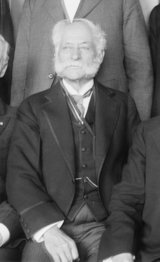
Henry Heinz
When Andrew Jackson was 36, the Heinz company, founded by Henry Heinz, began producing what would become one of America's favorite condiments—ketchup. With its distinctive keystone-shaped glass bottle, Heinz Ketchup was one of America's first packaged foods available to Andrew Jackson. The popularity of Heinz ketchup caused a surge in pre-packaged foods in America.
Daughter Alice Esther born, 1869
On 9 September 1869, Andrew Jackson's daughter, Alice Esther, was born when Andrew Jackson was 36 years old. The family was living in Rome Township, Crawford, Pennsylvania, United States at the time.
Jehovah's Witnesses, 1872

Charles Russell
In 1872, when Andrew Jackson was 39, the religious organization Jehovah's Witnesses was founded in Pennsylvania. A group of Bible students that lived near Pittsburgh began meeting to analyze the doctrines of the Bible, and they published what they learned in a magazine called The Watchtower. Charles Taze Russell led this group and served as the magazine's first editor. They believed in returning to Christ's original teachings and worshiping in the same way that first-century Christians did. The religion spread quickly, and soon many people around Andrew Jackson and around the world joined Jehovah's Witnesses organizations and churches.
Politics
Andrew Jackson and those around him tried their best to make sense of a changing world in the wake of the Civil War. The 14th and 15th amendments opened up new political opportunities for Americans across the country, allowing both white and black males the right to vote, but controversial legislation and racism inhibited many Americans from fully participating in the political sphere. Women were still excluded from politics, though married women received more education and conceived fewer children than their predecessors, while founding reform groups around issues like women's health, women's rights, temperance, and child labor, which were some of the issues at the forefront of politics during Andrew Jackson's lifetime. Slavery and Reconstruction were also key concerns, as the United States struggled to adjust to racial tension. Western settlement and new technology prompted significant changes in American politics over the course of the century.
Blue Jeans, 1873

Levi Strauss
In 1873, when Andrew Jackson was 40, a German immigrant named Levi Strauss patented denim pants, which would later be known as jeans. Blue jeans, which Strauss had actually invented years earlier, soon became commonly worn by miners and farmers in Andrew Jackson's country. Eventually, blue jeans revolutionized the world of fashion, becoming a staple in many closets in the U.S. and around the world.
The Long Depression, 1873 - 1878
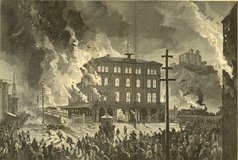
Burning of the Union Depot at Pittsburg during the Great Railroad Strike of 1877
When Andrew Jackson was 40 years old, one of the worst financial crises in the history of the United States struck the nation. This has gone down in history as the "Long Depression" and, in many ways, it was a worse disaster than the Great Depression of the 1930s.
For years, banks, businesses and private citizens had invested heavily in the building of railroads, expecting an easy profit; unfortunately, many of the new railroad lines did not generate enough funds to maintain them. The bubble finally burst in 1873 and caused many large banks across America to collapse. Many people in the nation lost their life savings in the process, and businesses had difficulty securing the funds needed to continue operations. As the crisis worsened, there was a downturn in many industries that helped supply the railroads, such as the steel industry, and factories began closing their doors.
Many members of Andrew Jackson's community would have been affected by the economic downturn. Those working in industrial cities found themselves part of the growing mass of the unemployed, while rural farmers suddenly found the banks trying to collect their debts and being unable to pay. Many workers began to wander the countryside, searching for work wherever it could be found, while the employed faced slashed wages as companies sought to save money.
As a result, many workers turned towards the unions to help protect them. Meanwhile, farmers joined the Grange, a farmers' union that sought to pressure government to pass laws to protect them. A series of strikes began to occur across the nation, many of them protesting the lowering of wages and unsafe working conditions. These strikes were often met with violence, as state governors called out the state militias to suppress the workers. Armories were built in many major American cities, enabling the government to quickly stamp out any workers' insurrections. This further undermined people's trust in leaders who seemed to support the wealthy over everyday Americans, and the People's Party and other reform movements began to gain traction across the nation, vowing to root out corruption and make the government more responsive to the people's will. Others began to turn to more radical political movements, such as socialism and anarchism, which seemed better suited to explain and rectify the ills of the day.
The Long Depression would last until 1878, but the economy remained shaky, and another downturn would occur in the early 1890s. Throughout this time, nearly every member of Andrew Jackson's community would have felt the impact of this catastrophic event.
Telephone, 1876
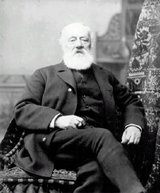
Antonio Meucci, the true inventor of the telephone

Alexander Graham Bell
When Andrew Jackson was 43, Americans and people around the world were excited by the emergence of an incredible new communication technology: the telephone. Sixteen years earlier, in 1860, Antonio Meucci - a highly educated Italian immigrant - demonstrated the "teletrofono" voice communication device in New York. Meucci had created the system to help care for his wife, who was paralyzed and bed-bound. Years later, Scottish-born, Boston-based inventor Alexander Graham Bell allegedly utilized Meucci's plans and materials (they shared a laboratory) and patented what was widely reported in newspapers as the first functioning telephone. He showcased his device for the first by calling his assistant and announcing the famous line, "Mr. Watson, come here, I want to see you."
Meucci sued Bell over the patent, but died before the court heard the case. Bell's claim to the telephone soon came under fire from another inventor named Elisha Gray. On February 11, 1876, Gray had filed a patent for a device that could transmit musical tones, but not speech. Later that same day, Bell filed the patent for his proposed telephone. A well publicized lawsuit followed, but in the end Bell was victorious. He went on to make a fortune from the telephone and was regarded by most people in Andrew Jackson's time as its rightful inventor. The Bell Telephone Company also became one of the giants in the new telecommunications industry. It wasn't until more than 100 years later, in 2002, that the United States Congress officially recognized Antonio Meucci as the actual inventor of the telephone.
Commerce

Paper bills from the 1880s
Towns and cities were being established across the United States during the 1800s, and as the population grew many people around Andrew Jackson stopped practicing subsistence farming and worked in other jobs, such as blacksmithing or tanning. Bartering was still common during Andrew Jackson's life, as many of the local farmers would use their crops to barter for goods. Technology was also improving, so it was possible to farm more land with fewer people.
Around the beginning of the century, the United States began to print its own money in order to solve the problem of foreign currency circulating in the economy. Andrew Jackson and his neighbors began to use U.S. dollars instead of British shillings and pence.
Department stores began to appear in the larger U.S. cities across the United States in the latter half of the century. This allowed people like Andrew Jackson's friends and family to purchase goods at set prices rather than through the barter system, where the price could vary from person to person.
Wharton School, 1881
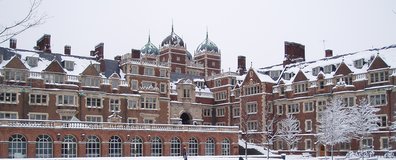
A building at Wharton School of Business
In the late 1800s, Philadelphian Joseph Wharton—an iron miner and self-taught businessman—realized that the only current business education in the United States came through apprenticeships. When Andrew Jackson was 48, Wharton made headlines by donating $100,000 to the University of Pennsylvania in order to found a new "School of Finance and Economy." Wharton hoped that this new venture would allow Pennsylvanians and people across the country to gain a better understanding of business—thus creating a wider and more robust economy during the Industrial Revolution. For many young people in Andrew Jackson's community, this opened up a new avenue of potential study and new career choices, as well.
Time Zones, 1883

Time zones helped prevent excessive waiting at train stations
When Andrew Jackson was 50, time zones were introduced in the US for the first time. Before 1883, most local communities rendered time based on "high noon," when the sun was at its highest point. As railroads led to faster travel and commerce between distant communities, the lack of a standardized time zone caused confusion and chaos with regards to times of arrival and departures at train stations. Railroad companies created time zones in 1883 to make travel and commerce easier and more organized for people around Andrew Jackson. This change was well-received and very successful, and within a year, international time zones were established, improving navigation around the world.
Homestead Strike, 1892
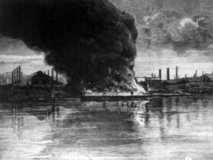
Strikers burning the Pinkerton barge
By 1892, tensions had reached a boiling point between large business owners and workers across much of the country. This became extremely evident in Pennsylvania, where 59 year-old Andrew Jackson lived at the time. Workers at one of Andrew Carnegie's steel mills in Homestead voted to go on strike to protest poor wages. The manager of the steel mill, Henry C. Frick, refused to budge. He was willing to do anything to break the strike, and had Carnegie's full support. Frick hired a private army from the Pinkerton Detective Agency to put down the strike, but this action led to an all-out battle on July 6th, 1892, with more than 3,000 workers clashing with the security agents. Twelve people were killed in the fighting, and the state militia was sent in to end the strike, bringing in strike-breakers to replace the workers in the mill. For much of the working class in Andrew Jackson's part of Pennsylvania, the Homestead Strike would serve as an inspiration and rallying cry. On the larger scene, though, the events set back the efforts for unionized labor, as the U.S. government refused to acknowledge them for years to come.
Professional Football, 1892
In 1892, when Andrew Jackson was 59, the first professional American football game was played. Purely an amateur sport up to this point, the game between the Allegheny Athletic Association and the Pittsburgh Athletic Club saw the two clubs reach out to top college players to join their teams for a Columbus Day match-up. William "Pudge" Heffelfinger, a star at Yale, was paid $500 to travel to Pittsburgh and play for the Allegheny squad—making him the first known football player to be paid in the U.S. By the early 20th century, the first professional leagues would form, and American football would soon become one of the most popular sports in the country.
Father dies, 1894
Andrew Jackson's father Robert Kerr passed away in Oil Creek Township, Crawford, Pennsylvania, United States at the age of 89. Andrew Jackson was 62.
Milton E. Kerr dies, 1895
Andrew Jackson's child Milton E. Kerr passed away at the age of 32. Andrew Jackson was 62.
Plessy v. Ferguson, 1896
Andrew Jackson was 63 when the case of Plessy v. Ferguson was heard before the United States Supreme Court. Addressing the discrimination still faced by African-Americans in a post-slavery America, the Court's eventual ruling established the precedent of "separate but equal." This upheld the legality of having separate, segregated facilities and institutions for whites and blacks, be it water fountains or school systems. Plessy's defeat led to increased discussion over civil rights in America, but blacks would still face the obstacles of legal segregation for decades to come.
Marconi Invents Radio, 1897
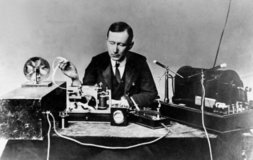
Marconi demonstrating the radio
Following in the tradition of dozens of Italian scientists and inventors, Guglielmo Marconi began studying at the Livorno Technical Institute in 1894. Focusing his efforts on understanding radio waves, he had patented a basic system of wireless telegraphy—the radio—by 1897. Marconi's first radio waves were initially short, averaging only a mile and a half long. But in 1901, he was able to receive a wireless transmission from across the Atlantic, and kept refining his technology until he could transmit from Nova Scotia to Ireland. He received the Nobel Prize in physics in 1909. In 1912, the Titanic famously signaled for help using Marconi's invention.
Even after his initial successes, Marconi continued to study and develop his science, assisting in the creation of the British Broadcasting Company (BBC) and the development of radar technology. But Marconi would remain most well-known for inventing the radio, bringing increased enjoyment, safety, and information to Andrew Jackson's neighbors and relatives. Many members of Andrew Jackson's community soon could not imagine their lives without the existence of radio.
1897 Coal Miner Strike, 1897

Miners striking in Lattimer, Pennsylvania
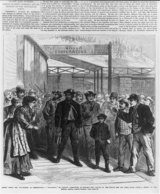
A depiction of part of the strike
When Andrew Jackson was in his 60s, many of his neighbors found employment in nearby coal mines, toiling in dangerous conditions for little pay. By 1897, miners in Pennsylvania, Ohio, Illinois, Indiana, and West Virginia had had enough. On July 4, the United Mine Workers of America union called for its 10,000 members to walk off the job—and 150,000 frustrated miners across the region joined in.
For weeks, the miners refused to return to work, despite threats from their employers. On September 10, an argument between a sheriff's posse and striking workers near Hazelton, Pennsylvania boiled over into violence. Nineteen unarmed miners were killed and several more wounded in a confrontation later known as the Lattimer Massacre.
One day later, Andrew Jackson's community received news that the strike had ended. The protestors were relieved to learn that their efforts had not been in vain: employers promised to limit shifts to eight hours. They also agreed to pay workers more regularly and in cash, rather than in credits at the employers' stores. Andrew Jackson's neighbors hoped that the mine owners would hold up their end of the bargain, improving working conditions and quality of life for their families.
Spanish American War, 1898

A battle of the Spanish-American War
During Andrew Jackson's lifetime, the United States began to establish itself as a world power, and began to intervene in international affairs in places like the Philippines, Hawaii, and Cuba. Unfortunately for U.S. foreign relations, this caused a lot of tension, resulting in several conflicts including the Spanish-American War of 1898. Americans around Andrew Jackson were shocked to read the sensational news articles detailing the alleged Spanish attack on the U.S.S. Maine in Cuba. Although only a few thousand Americans died in the war, the U.S. established itself as a major player on the world stage. Many people around Andrew Jackson learned about the war through "yellow journalism," or newspaper articles that contained exaggerated information to promote the war and sell copies.
Brother James Rulin dies, 1900
Andrew Jackson's brother James Rulin Kerr passed away at the age of 56. Andrew Jackson was 67.
US Steel Corporation, 1901

Andrew Carnegie
In 1901, the United States Steel Corporation was established, with its headquarters in Pittsburgh, Pennsylvania. This was major news not just to Andrew Jackson's fellow Pennsylvanians, but to steel workers, investors, and business leaders around the world. A merger of several other steel manufacturing companies, U.S. Steel had the backing of some of the nation's most powerful business magnates, including J.P. Morgan and Andrew Carnegie. Overnight, it became the largest business enterprise in the history of the country, and was producing 65% of the nation's steel within a year. Locally, Pennsylvania's dominance as an epicenter for the steel industry created countless jobs and led to population booms in Pittsburgh and many other industrial towns.
Mining Strike, 1901
When Andrew Jackson was in his 60s, mining was a very important industry for the Pennsylvania economy. Unfortunately, the miner's occupation consisted of long days in dangerous locations for little pay. Seeking to improve their situation, the state's miners formed a union and requested a 20% increase in pay and a reduction from ten to eight hour workdays. Once these demands were ignored multiple times, the union elected to go on strike in 1901. Over 100,000 miners from northeastern Pennsylvania joined the cause and kept the mines closed all summer, until President Teddy Roosevelt himself intervened in the negotiations. The labor battle wasn't just a major news story, it directly impacted many people in Andrew Jackson's part of the country, as the desire for better treatment also brought the risk of losing the ability to provide for one's family.
Wright Brothers, 1903
When Andrew Jackson was 70 years old, brothers Orville and Wilbur Wright successfully designed and flew the world's first heavier-than-air, human-piloted aircraft. That initial flight in Kitty Hawk, North Carolina, lasted less than a minute and didn't actually gain much public attention. By 1905, though, Andrew Jackson's local newspaper would follow the Wright Brothers closely as their increasingly sustained flights became a national sensation. Within a few short decades, the modern airplane would completely revolutionize travel for people all over the world.
Ford Motors, 1903
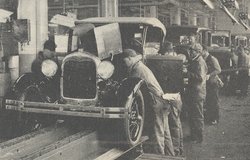
Ford Motor Company
In June of 1903, when Andrew Jackson was 70, Henry Ford changed transportation forever by founding the Ford Motor Company in Dearborn, Michigan. In its early years, the company revolutionized manufacturing with its improved version of the assembly line, which had been patented by Ransom Olds of the Oldsmobile company a few years prior. Ford's version of the assembly line used an innovative conveyor system, in which the chassis of the car were towed by a rope from station to station, making production quicker and more efficient. Ford also set a precedent by providing a decent wage for his workers—$5 for a 9-hour day. The introduction of the Model T a few years later allowed millions of middle-class Americans to affordable automobiles.
Harwick Mine Disaster, 1904
Since mining was such an important piece of Pennsylvania's economy, people all around 71 year-old Andrew Jackson were shocked when 179 coal miners were killed in an accident on January 25, 1904. Miners in Harwick frequently used dynamite in their efforts to extract coal, but a dynamite explosion ignited the methane and coal dust that were suspended in the air, killing nearly everyone inside the mine. Only 1 miner made it out alive, and two more people were tragically killed trying to rescue the trapped workers. Andrew Jackson's friends and neighbors worried about the safety of their loved ones who worked in mines across Pennsylvania, and sadly, their worst fears were confirmed. Over the next four years, more than 400 more miners were killed in similar accidents.
Sister Mary Ann dies, 1904
Andrew Jackson's sister Mary Ann Kerr passed away at the age of 65. Andrew Jackson was 72.
Hershey's, 1905
While steel and mining had long been major parts of Pennsylvania's economy, a new industry entered the scene when Andrew Jackson was 72: chocolate. Milton Hershey had been tinkering with a formula for affordable mass-produced milk chocolate on his family farm for a few years, and in 1905, he constructed a massive chocolate factory in Derry Township, a rural area near Harrisburg. Hershey's factory would go on to employ hundreds of Andrew Jackson's fellow Pennsylvanians. The popular and affordable chocolate treats they produced were shipped across the country and around the world. As a result, the town Hershey built for his employees grew rapidly, and included a school for orphans as well as a zoo and amusement park.
Brother David G. dies, 1905
Andrew Jackson's brother David G. Kerr passed away at the age of 71. Andrew Jackson was 72.
Brother Warren dies, 1905
Andrew Jackson's brother Warren Kerr passed away in Titusville, Crawford, Pennsylvania, United States at the age of 56. Andrew Jackson was 72.
First Radio Broadcast, 1906
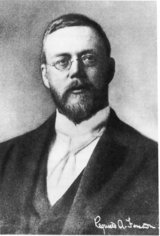
Reginald Fessenden
On Christmas Eve of 1906, the Canadian inventor Reginald Fessenden successfully executed the first radio broadcast—a Christmas concert sent out from a radio tower in Massachusetts to crews aboard United Fruit Company ships in the Atlantic Ocean. This was a major milestone in communication, and made news around the world. Soon, people like 73 year-old Andrew Jackson would be able to enjoy this new technology for communication, news, and entertainment.
Andrew Jackson dies, 1911
Andrew Jackson died when he was 78 years old in Mercer, Mercer, Pennsylvania, United States.
Reduce Time Line







